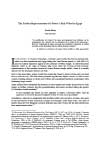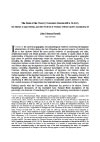Qenamun
« The Earliest Representation of a Potter’s Kick-Wheel in Egypt »
ENiM 6, 2013, p. 169-176.
 En se fondant sur deux représentations du temple Hibis, les céramologues ont longtemps supposé que le tour de potier à pied rapide n’est apparu en Égypte qu’à la période saïto-perse. Une figuration détaillée de Khnoum provenant d’une inscription de Ramsès II au temple de Louqsor récemment découverte indique, cependant, que cette technologie était déjà utilisée au Nouvel Empire.
En se fondant sur deux représentations du temple Hibis, les céramologues ont longtemps supposé que le tour de potier à pied rapide n’est apparu en Égypte qu’à la période saïto-perse. Une figuration détaillée de Khnoum provenant d’une inscription de Ramsès II au temple de Louqsor récemment découverte indique, cependant, que cette technologie était déjà utilisée au Nouvel Empire.
 Based on two representations from Hibis temple, ceramicists have long assumed that a fast kick wheel did not appear in Egypt until the Saite-Persian period. A detailed representation of Khnum from the recently uncovered building inscription of Ramesses II at Luxor temple, however, indicates that this technology was already in use during the New Kingdom.
Based on two representations from Hibis temple, ceramicists have long assumed that a fast kick wheel did not appear in Egypt until the Saite-Persian period. A detailed representation of Khnum from the recently uncovered building inscription of Ramesses II at Luxor temple, however, indicates that this technology was already in use during the New Kingdom.
 Consulter cet article (54354) -
Consulter cet article (54354) -  Télécharger cet article au format pdf (24116)
Télécharger cet article au format pdf (24116)
« The Stela of the Viceroy Usersatet (Boston MFA 25.632), his Shrine at Qasr Ibrim, and the Festival of Nubian Tribute under Amenhotep II »
ENiM 7, 2014, p. 239-276.
 La stèle de Semna, du vice-roi de Nubie de la XVIIIe dynastie, Ousersatet, consigne un conseil donné par Amenhotep II à son vice-roi sous la forme d’une copie monumentale de la transcription personnelle du roi de son propre décret royal à Ousersatet. Le décret fut promulgué durant une fête célébrant l’accession royale, à une date secondaire, apparemment pour lier l’accession royale à la fête k?-?r-k?, à l’image de Ramsès III qui, plus tard, célébrera à la fois son accession et une fête de l’accession royale associée à la fête de Néhebkaou. Dans ce texte, Amenhotep II conseille Ousersatet quant aux interactions des Égyptiens et Nubiens avec l’administration du vice-roi et éclaire un peu les relations entre le roi, le vice-roi et les membres nubiens de la bureaucratie égyptienne du sud. La nature apparemment obscure et poétique du conseil royal et le manque de clarté quant à la situation d’Amenhotep II lorsqu’il le prodigue expliquent l’attention portée à ce texte, mais un certain manque de rigueur dans l’interprétation a obscurci plusieurs analyses de l’inscription. Un nouveau collationnement et un examen du texte de la stèle révèlent qu’Amenhotep II aborde apparemment la question de l’intégration croissante, par le vice-roi, de Nubiens dans les niveaux les plus élevés de l’administration du sud. Amenhotep II utilise une formule apparemment proverbiale qui fait référence à la transmission de l’autorité plus ancienne du vice-roi aux plus grandes divisions de la bureaucratie, et à la création d’un équivalent nubien du vice-roi, ce dernier restant néanmoins le primus inter pares de l’administration.
La stèle de Semna, du vice-roi de Nubie de la XVIIIe dynastie, Ousersatet, consigne un conseil donné par Amenhotep II à son vice-roi sous la forme d’une copie monumentale de la transcription personnelle du roi de son propre décret royal à Ousersatet. Le décret fut promulgué durant une fête célébrant l’accession royale, à une date secondaire, apparemment pour lier l’accession royale à la fête k?-?r-k?, à l’image de Ramsès III qui, plus tard, célébrera à la fois son accession et une fête de l’accession royale associée à la fête de Néhebkaou. Dans ce texte, Amenhotep II conseille Ousersatet quant aux interactions des Égyptiens et Nubiens avec l’administration du vice-roi et éclaire un peu les relations entre le roi, le vice-roi et les membres nubiens de la bureaucratie égyptienne du sud. La nature apparemment obscure et poétique du conseil royal et le manque de clarté quant à la situation d’Amenhotep II lorsqu’il le prodigue expliquent l’attention portée à ce texte, mais un certain manque de rigueur dans l’interprétation a obscurci plusieurs analyses de l’inscription. Un nouveau collationnement et un examen du texte de la stèle révèlent qu’Amenhotep II aborde apparemment la question de l’intégration croissante, par le vice-roi, de Nubiens dans les niveaux les plus élevés de l’administration du sud. Amenhotep II utilise une formule apparemment proverbiale qui fait référence à la transmission de l’autorité plus ancienne du vice-roi aux plus grandes divisions de la bureaucratie, et à la création d’un équivalent nubien du vice-roi, ce dernier restant néanmoins le primus inter pares de l’administration.
 The Semna stela of the Eighteenth Dynasty Viceroy of Nubia, Usersatet, records Amenhotep II’s advice to his viceroy in the form of a monumental copy of the king’s personal transcription of his own royal decree to Usersatet. The decree was issued during a festival celebrating the royal accession on a secondary date, apparently in order to link the king’s accession to the k?-?r-k? festival, just as Ramesses III later would celebrate both his actual accession and a festival of royal accession associated with the Nehebkau festival. Amenhotep II offers advice to Usersatet regarding interactions of Egyptians and Nubians within the viceregal administration, and shed some light on the interactions of king, viceroy, and Nubian members of the Egyptian bureaucracy in the south. The seemingly obscure and poetic nature of the king’s advice, and the lack of clarity regarding the situation about which Amenhotep II offers his advice, have led to considerable modern attention to the text, but a certain looseness of interpretation has plagued many examinations of the inscription. A new collation of the stela, and an examination of the text, reveal that Amenhotep II was apparently addressing the viceroy’s increasing integration of Nubians into the higher levels of the southern administration. Amenhotep II quotes an apparently proverbial saying that refers to a devolution of earlier viceregal authority into greater divisions of bureaucracy, and the creation of a Nubian counterpart to the viceroy, the latter remaining nevertheless the primus inter pares of the administration.
The Semna stela of the Eighteenth Dynasty Viceroy of Nubia, Usersatet, records Amenhotep II’s advice to his viceroy in the form of a monumental copy of the king’s personal transcription of his own royal decree to Usersatet. The decree was issued during a festival celebrating the royal accession on a secondary date, apparently in order to link the king’s accession to the k?-?r-k? festival, just as Ramesses III later would celebrate both his actual accession and a festival of royal accession associated with the Nehebkau festival. Amenhotep II offers advice to Usersatet regarding interactions of Egyptians and Nubians within the viceregal administration, and shed some light on the interactions of king, viceroy, and Nubian members of the Egyptian bureaucracy in the south. The seemingly obscure and poetic nature of the king’s advice, and the lack of clarity regarding the situation about which Amenhotep II offers his advice, have led to considerable modern attention to the text, but a certain looseness of interpretation has plagued many examinations of the inscription. A new collation of the stela, and an examination of the text, reveal that Amenhotep II was apparently addressing the viceroy’s increasing integration of Nubians into the higher levels of the southern administration. Amenhotep II quotes an apparently proverbial saying that refers to a devolution of earlier viceregal authority into greater divisions of bureaucracy, and the creation of a Nubian counterpart to the viceroy, the latter remaining nevertheless the primus inter pares of the administration.
 Consulter cet article (40866) -
Consulter cet article (40866) -  Télécharger cet article au format pdf (21841)
Télécharger cet article au format pdf (21841)
ENiM 18 - 2025
4 article(s) - 11 mars 2025.
ENiM 1 à 18 (2008-2025) : 223 articles
4 019 414 téléchargements
8 332 183 consulations.
Index des auteurs

Mots clés

Derniers articles : 
Robert Steven Bianchi
Duplication and Continuity
(ENiM 18, p. 13-36 — 11 mars 2025) 
Frédéric Mougenot
Rénénoutet à la porte de la maison
(ENiM 18, p. 1-12 — 29 janvier 2025) 
CENiM - Mise en ligne des volumes Ă©puisĂ©s : 
 Anne-Sophie von BOMHARD DĂ©cans Ă©gyptiens, CENiM 23, Montpellier, 2020 — (2020)
Anne-Sophie von BOMHARD DĂ©cans Ă©gyptiens, CENiM 23, Montpellier, 2020 — (2020) 
 Jean-Claude Grenier L'Osiris ANTINOOS, CENiM 1, Montpellier, 2008 — (26 dĂ©cembre 2008)
Jean-Claude Grenier L'Osiris ANTINOOS, CENiM 1, Montpellier, 2008 — (26 dĂ©cembre 2008) 
TDENiM - Mise en ligne des volumes Ă©puisĂ©s : 
 Twitter
Twitter 3615178 visites - 4598 visite(s) aujourd’hui - 115 connecté(s)
© ENiM - Une revue d’égyptologie sur internet
Équipe Égypte Nilotique et Méditerranéenne - UMR 5140 - « Archéologie des Sociétés Méditerranéennes » (Cnrs) - Université Paul Valéry - Montpellier III























 Contact
Contact
 Abonnez-vous !
Abonnez-vous ! Équipe Égypte Nilotique et Méditerranéenne
Équipe Égypte Nilotique et Méditerranéenne UMR 5140 « Archéologie des Sociétés Méditerranéennes » (Cnrs)
UMR 5140 « Archéologie des Sociétés Méditerranéennes » (Cnrs) Université Paul Valéry - Montpellier III
Université Paul Valéry - Montpellier III